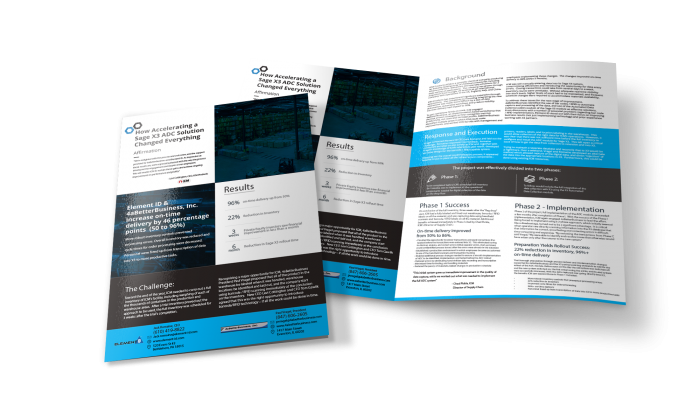
“We’re delighted with the process and outcomes, and the support provided by 4aBetterBusiness and Element ID, as impressive as those results are, we’re especially pleased with the way the process developed the engagement and buy-in of our employees. This will enable ICM to sustain those gains and achieve ongoing improvements in performance and profits.”
– Levi Cottington, ICM CEO
Background
ICM Products (ICM) is a specialty chemical company producing an industry-leading array of chemical compounds including silicone polymers, defoamers and specialty emulsions for a wide variety of applications. The company has grown through acquisition from a single US location to an international company with operations in the US, England, Italy, and China.
ICM Products has experienced significant expansion through acquisitions. The complexity surrounding integrating the new operations was made more difficult by a lack of data automation, automated workflows and product visibility. On-time delivery had slipped to 50%.
To get operations firmly on track, ICM engaged 4aBetterBusiness, an implementation-based consultancy that deploys proven strategies to help companies improve productivity, cut costs and increase profits. 4aBetterBusiness identified multiple areas in which ICM could make improvements, and worked side-by-side with management and employees implementing those changes. The changes improved on-time delivery to 86% within 5 months.
ICM was still manually entering data into its Sage X3 system, compromising efficiencies and introducing the opportunity for data entry errors. Closing transactions could take from several days to a week. Inventory counts were unreliable. Without adequate real-time visibility into stock levels, higher levels of stock had to be maintained, and frequent schedule changes were required to accommodate materials availability.
To address these issues for the next stage of improvement, 4aBetterBusiness identified the use of bar codes / RFID to automate capture and processing of the data, and use of the Automated Data Collection (ADC) module of the Sage X3 module as effective solutions. From discussions with a number of potential providers regarding bar code / RFID implementation, Element ID stood out with their focus on improving business results (not just implementing technology) and prior experience working with X3 partners.
Opportunity and Challenge
Toward the end of the year, ICM needed to carry out a full inventory of ICM’s facility, including weighing of each of the thousands of containers in the production and warehouse areas. After a trial inventory proved out the approach to be used, the full inventory was scheduled for 3 weeks after the trial’s completion.
Recognizing a major opportunity for ICM, 4aBetterBusiness President Paul Vragel proposed that all of the product in the warehouse be barcoded when it was handled, warehouse locations be identified and laid out, and the company start using barcode / RFID scanning immediately at the conclusion on the inventory. New CEO Levi Cottington and CFO Tom Gawlik agreed that this was the right opportunity to introduce barcoding technology – if all the work could be done in time.


Response and Execution
Vragel contacted Element ID CEO Jack Romaine and laid out the challenge. Romaine responded immediately. Romaine conducted an initial on-site survey at ICM and, together with Vragel’s knowledge of ICM’s operations and needs, developed an initial design for the barcode / RFID-capable system.
Mapping out the overall implementation process, it appeared feasible to put in place all the infrastructure components – printers, readers, labels, and location labeling in the warehouse. This would allow collection of the right data for ICM’s operations. However, it was clear that there was not sufficient time before the full inventory to configure and install the ADC module for Sage X3. This left open a critical issue of how to get the data from collection to retention and into X3.
Trying to maintain a separate database and reconcile that to X3 would be a nightmare. Over a weekend, Vragel and Romaine developed an alternate method which allowed capture of the digital data, and direct “injection” of the data into the appropriate locations in X3. Furthermore, this could be done using existing ICM resources.
|
The project was effectively divided into two phases:
|
| Phase I: |
| to be completed before ICM’s scheduled full inventory (in 3 weeks), was to implement all the operational components needed for digital collection of the data on the shop floor
|
| Phase 2: |
|
to follow, would include the full integration of the data collection with X3 using the X3 Automatic Data Collection module.
|
Phase I –Establish Digital Data Capture System
Within 3 weeks:
Element ID identified, obtained, purchased and configured the needed equipment (handheld barcode/RFID scanners, barcode/RFID printers, barcode/RFID labels and separate equipment for the capture database) and came on-site for the final week of implementation, along with a senior engineer from an X3 implementation partner.
4aBetterBusiness led the efforts for ICM, determining the processes that needed to be in place to capture data on ICM’s operations and how those transactions would be defined in the system, labeling of warehouse locations and development and delivery of operator training. Capture processes were developed, tested, and documented. Operator training was developed and operators were trained in use of the system.
According to Jack Romaine from Element ID, “Technology is only a part of the total solution in these types of projects. The human element is often your biggest risk. Paul Vragel of 4aBetterBusiness was a critical part of the solution by assuring success through understanding the existing process, training the operators, and getting the “buy-in” at all tiers of the company to assure the system would be used”.
Phase I – Success
|
“This initial system gave us immediate improvement in the quality of data capture, while we worked out what was needed to implement the full ADC system”
– Chad Pickle, ICM , Director of Supply Chain
|
On conclusion of the full inventory, three weeks after the “flag drop” start, ICM had a fully labeled and lined-out warehouse, barcode / RFID labels on all the material, and was capturing data using handheld scanners and barcode / RFID labels on all the material.
Additional benefits achieved immediately in Phase I cited by Pickle:
- Provided the opportunity to review transactions and apply corrections if/as needed before the transactions were entered into X3. This eliminated having to discover, analyze, and correct errors (initial operator errors, start-up issues, as-yet-unidentified process issues) after the errors were already in the database
- Established a production environment in which employees became accustomed to use of the handheld scanners and transaction tracking
- Enabled additional process changes needed to ensure a smooth implementation of ADC to be identified, implemented, and tested before the ADC rollout
- Reduced errors by eliminating hand-written data recording and transcription
- Minimized time for finding and handling materials
- Reduced frequency of materials-related changes in production schedule
On-time delivery improved from 50% to 86%.
Phase 2 – Value-Added Implementation of ADC
Phase 2 of the project, full implementation of the ADC module, proceeded a few months after completion of Phase I. With the success of the Phase I implementation, ICM again engaged 4aBetterBusiness to lead the effort.
Being forced to implement using a 2-phase approach, which initially seemed like a disadvantage, turned out to be a significant advantage. It is critical when operators are directly scanning information into the X3 database that that information be correct, since finding and correcting errors is difficult, time-consuming and expensive. “By reviewing the transactions from Phase I”, said Vragel, “We were able to identify and resolve issues that otherwise would have arisen only after the cutover to the new system.”
Preparation Yields Rollout Success: 22% reduction in inventory, 96%+ on-time delivery
The thorough preparation through process reviews and implementation changes supported by 4aBetterBusiness and the X3 partner paid big dividends to ICM for the rollout of the ADC module.
Before noon on the day the old system was switched off and the new system switched on, the first orders using the entire, end-to-end system were being successfully processed.
With the data captured now going directly into X3, the benefits ICM saw beyond those in Phase 1 included:
- More robust inventory controls that prevented processing errors
- 22% reduction in inventory
- Improved cycle times for order processing
- 96%+ on-time delivery
- Personnel freed up from transcription of data into X3 to more productive tasks

4aBetterBusiness, Inc.
Address: 1417 Main Street Evanston, IL 60202
Phone:(847) 606-2605
Paul Vragel, President
pvragel@4abetterbusiness.com

Element, ID
Address: 520 Evans St #3, Bethlehem, PA 18015
Phone: (610) 419-8822
Jack Romaine, CEO
sales@element-id.com



You’re reading this because you either already own Sage X3 or you are thinking about buying it. It’s great for accounting and Sage is clearly a leader in the field. But if that’s all your using it for you are really missing out.
We’ve seen many customers select Sage X3 because of the other capabilities it has – specifically the built in manufacturing and warehouse management features. If you are thinking about buying X3, this is worth repeating. These features are already built in so make sure you factor in third party add-ons you need with the other products when comparing them to X3.
If you already have X3, guess what? You already own these capabilities!
Now let’s talk about how to use them.
The best way to leverage these features is through the automatic data capture (ADC) interface. Basically, by adding an ADC license, you can use a barcode scanner to input data into X3 real time. By feeding real time data into the integrated manufacturing and warehouse management features noted above, you get a real time window into your business.
What does this mean? It means you know how much you have and where it is. Everything, finished goods, WIP, or raw materials! It means you can issue materials to a work order real time and production track real time. Want to know how second shift is doing during the shift? Now you can because the data is being captured real time.
What do you need? You need barcodes so that means printers and label stock. You need scanable address locations so that is more barcodes. You, of course, need handheld barcode scanners that run a terminal emulator connected to your X3 ADC server. And that connection from handheld to server usually occurs over WiFi – so you need wireless access points anywhere you want to scan.
Your X3 reseller can help you with all the Sage licensing and ADC configuration, but you will need a trusted hardware vendor to help with the rest. You can buy components on the Internet, but you greatly increase your success and reduce your risk if you find a trusted integrator that can provide all of the scanners, printers, WiFi, and device software you need.

According the US Department of Labor, compensation costs in the US increased 2.2% in 2016. Did this reduce your corporate profits? A typical manufacturer that we work with is spending about six minutes per transaction recording production using pen and paper. Often, we find their production workforce allocating 10% of their time to data collection.
By switching to RFID, manufacturers experience several immediate benefits. Profitability increases because production output goes up when employees aren’t burdened by data collection, and instead focus on the jobs they were hired for. Imagine every production worker in your plant working 11% longer and not having to pay them a penny more. Profitability also increases because managers make better decisions using real time data. There is less waste and production bottlenecks are resolved more quickly when managers immediately spot changes in output and address them. The data set improves with machine captured data versus the chronic errors that result from transposed numbers, illegible handwriting, and missing slips of paper that are common in pen and paper tracking.
The best applications for RFID are automated tracking of trays, bins, totes, and other containers that are used over and over. The RFID data capture devices are mounted in key areas or on production equipment and provide fully automated, hands-free scanning of these containers. This can update a products location, update its stage in the production process, issue raw materials to a work order, or production track newly produced WIP or finished goods. Linking these records produces real time traceability records.

Think of it like the toll roads.
Remember when you had to stop and get the ticket to get on and then stop again to pay on the way off? That is like pen and paper data collection. RFID is like the express lane where you never even need to slow down. By the way, those toll tags are actually a more expensive form of the RFID we deploy in manufacturing. It means higher profits for your company and it can help you offset rising compensation costs.
Is 2017 the year you will implement the project to increase your profits?
Your bonuses?
Create the opportunity to pay your employees more without hurting the bottom line?

Let’s take a step back from RFID and pay homage to that which came before – the barcode! Barcodes gained in popularity over 40 years ago and have been the workhorse for product identification ever since. Part of the problem with RFID expectations and adoption rate started with the technology being marketed as a replacement to barcodes rather than a supplement. Couple that with RFID taking shape in its own silo outside of the traditional automated data collection (ADC) market and it is no surprise that we ended up with RFID vs barcode like Ali vs Fraser or Yankees vs Red Sox instead of thinking about barcode and RFID as two stars on the same team.
Barcodes are proven technology. There is a great ecosystem in place to support the deployment of both the labels and the infrastructure. A typical manufacturer or warehouse has plenty of choices and there are lots of good integrators that can successfully complete a project. And let’s not forget that deploying barcodes generates a high return on investment because the technology is relatively inexpensive, but packs a lot of punch in its ability to improve inventory management and traceabililty.
Our philosophy is that every facility would benefit from a combination of barcode and RFID. Most integrators sell either a screwdriver or a hammer. As you would expect, they see every project as screws or nails. To the customer, however, there are just business problems. “We need data on this process” or “we need to find things faster in the warehouse”. The best way to help the customer is to evaluate each problem on its own and determine the best tool for that job. The best tool for “picking” is probably different than the best tool at the dock door. Issuing raw materials to a work order likely needs a different solution than creating finished case records.
The barcode isn’t going away anytime soon and RFID is never going to completely replace it, in our view. To us, barcode and RFID are different tools in the tool box that can make a business run better when applied effectively. We need more integrators that can apply either technology or perhaps more integrators to partner and work together so that the best technology is selected for each individual manufacturer’s challenge.
End customers need to be sure their integrator partner has evaluated both barcode and RFID for suitability and made the best choice for each aspect of the business based on value to the customer – not just because “I sell barcode” or “I sell RFID”. It would be rare for an optimized data collection system to be 100% barcode or 100% RFID.
So let’s toast to the barcode and apply it wisely. Cheers!

We are proud to announce that Element ID will be participating in VARTECH 2016 next week – September 12-14.
Please join us on Tuesday 9/13 in the afternoon to see our CEO, Jack Romaine, as a panelist for the Solution Session titled “Tracing Food & Beverage and Pharmaceuticals”.
Session 1: 1-2:30PM located in Hermes 1, 2, 3
Session 2: 2:35-4:05PM located in Hermes 1, 2, 3
Mr. Romaine will be joined by speakers from Zebra, Carlisle Technology, and Blue Rover on the panel moderated by BlueStar’s Rick Bird.
————–
VARTECH is the premiere event in the Channel for education and networking. A combination conference and trade show, VARTECH enables value-added resellers to cultivate rewarding relationships with hardware manufacturers and software solution providers. Vendors and resellers of POS, ADC, Mobility, RFID, Digital Signage and Security can take advantage of one-on-one product demonstrations, phenomenal networking opportunities and educational sessions presented by industry professionals.
Element ID is a specialty integrator focusing on full turnkey RFID solutions for manufacturing and warehouse customers. The company can help in all aspects of the project from design through sourcing of all required equipment and tags, setup, service, and support. Element ID also supplies and integrates barcode scanners, scales, dimensioners, and IoT appliances. A key feature of Element ID projects is the ability to directly integrate with the customer’s existing ERP. WMS, MRP, asset tracking, or other proprietary software solutions.
 It’s difficult to talk about any industry these days without hearing the phrase “Big Data”. In the era of the “Internet of Things” it seems every piece of consumer technology we encounter is communicating with the technology around it and everything we do online ends up in some marketing database. But how can a manufacturer leverage the Big Data innovations to increase profits and improve quality to drive higher sales? Is “Internet of things” real technology and can it help? Let’s get beyond the marketing flash and see how this can benefit manufacturing.
It’s difficult to talk about any industry these days without hearing the phrase “Big Data”. In the era of the “Internet of Things” it seems every piece of consumer technology we encounter is communicating with the technology around it and everything we do online ends up in some marketing database. But how can a manufacturer leverage the Big Data innovations to increase profits and improve quality to drive higher sales? Is “Internet of things” real technology and can it help? Let’s get beyond the marketing flash and see how this can benefit manufacturing.
First, the good news. Most manufacturers already own the costliest part of a Big Data system – the software to house and process the data. This is generally your ERP system but could also be an MES or MRP system. These software systems provide the tools to slice, dice, and analyze the data you collect. Oops. Now the bad news. Most manufacturers are not feeding these systems with real time data. Often that is because the cost of acquiring the data is high due to a reliance on pen, paper, and labor. The high wage cost (production level pay for entry level data collection), loss in productivity (a production worker is spending 20-30% of her time collecting data instead of producing), and bad/missing data have been the limiting factors. But there is a solution! Often with a payback period of 6 months or less!
“Internet of Things” is a marketing buzzword that is thrown around far too often. What it really refers to is the same type of automated data capture technology that has been around for 40 years. We are going to focus on two technologies in the “Internet of Things” that can most help manufacturers feed “Big Data” and reap the rewards of data crunching in the form of increased profits and more sales.
Use RFID to track location, movement, usage, cycles, production, and tie it together for traceability
The first is radio frequency identification (RFID). Automated RFID systems allow you to capture case, pallet, or item information by passing in the vicinity of an RFID read station. Mounting these on your equipment allows you to do real time material issues to a work order with full lot traceability and real time production tracking of new WIP or finished goods you produce. The cost of data acquisition is essentially zero and there is no human intervention. That means no missing or bad data from forgotten scans or lost/illegible tracking tickets. You can also automatically monitor throughput and process time at, and between, your workcells. Additionally, you can improve preventive maintenance on your molds and fixtures by measuring cycles and linking molds to early detection of quality issues.
An RFID system integrator will work with your ERP/MES/MRP provider to ensure a secure, flexible data collection and management partnership. An RFID system that can directly feed data into your existing ERP system allows your company the opportunity to get the highest return on its investment. RFID has the ability to provide your decision makers with the reliable information they need to make the tough calls to get your company operating at its highest potential.
Use IOT Appliances to monitor almost anything and automatically trigger corrective action
The second is IOT appliances. Despite the fancy name, these are basically the same sensor-based data acquisition systems that have been around for decades. What has changed is the ability of these devices to internally filter, process, and format the raw data and feed it directly into your MES or ERP system. IOT appliances allow you to connect production equipment to your software and monitor and record temperature, humidity, down time, alerts, flow, etc. As an example, let’s suppose you currently rely on a production worker to notice if the gauge on the oven is reading over temperature and hope they call someone from quality. Instead, your IOT appliance could continuously monitor the temperature and automatically put all trays coming from the oven during an over-temp event onto quality hold in your ERP system. Imagine having up/downtime data on a machine 24 hours a day and being able to view that at the same time you look at throughput data. Perhaps, most importantly, the output of these devices can be used to stop something that is going wrong in production almost immediately to allow corrective action. Virtually any measurement that can be captured electronically can now be part of the data suite you feed into your existing software systems.
Beyond the Buzzwords
Big Data is really about collecting as much information as possible about your production process and the resources you use. The cost to store and process this information is significantly lower than even a decade ago. From these data, you can develop your key performance indicators (KPIs) and success metrics. You can spot trends (good or bad) early and act on them. Since most customers already own the tools to house and process the data the form of ERP, MES, and MRP software, our focus has been on capturing and delivering the data to these systems in a cost effective manner.
The Internet of Things provides the data capture solution. Automated RFID systems capture the location, movement, usage, and production of materials, WIP, and finished goods. IOT appliances capture measurements and messages from your equipment. Advances in technology have allowed these devices to talk directly to the big data software and have greatly reduced the cost of data capture. By combining all this data together, manufacturers can now have the tools to improve profitability, increase capacity, and increase quality.

Debunking the myth that RFID tags always cost more than barcodes:
When comparing the consumable costs of an RFID solution relative to a barcode solution, it is very important to differentiate between “open” and “closed” loop applications. A closed loop application occurs when a tag is affixed to an asset or product carrier and used over and over again in the system. Many manufacturing companies use some type of product carrier like totes, trays, and bins.
These customers print a new identifying barcode each time the carrier is reused. This results in a lot of barcode printing. While each individual barcode may be cheaper than a corresponding RFID tag, the total cost must be evaluated.
Total barcode cost = (cost of individual barcode) * (number of carriers in the system during the time period) * (number of cycles for each carrier in that time period)
The advantage of RFID tags is that they can be permanently affixed to these carriers. Special coatings and fasten- ers can be used to make sure they stay on. They don’t smudge, tear, or fade. They can withstand temperature extremes and still work when covered with grease and grime. Selecting the right RFID tag can mean a tag is affixed only once and reused over and over for five or even ten years.
Total RFID cost = (cost of RFID tag) * (number of carriers)
An Example:
A customer with 5000 totes used twice a day with $0.04 barcodes would pay ($0.04) * (5000) * (2) = $400/day or $100K over a 250 day work year or $500K over 5 years. Using a permanent RFID tag with polypropylene coating and aggressive adhesive would reduce the total cost to ($0.30) * (5000) = $1500 over the same five year period – a savings in excess of $499K!
Looked at another way, the $1500 in RFID tag costs would have a payback period of just over two days for this customer. A modest RFID deployment (tags + infrastructure) at this manufacturer would be paid for in less than 6 months by label savings alone without any other benefit from using the RFID data. Once other benefits are considered, this customer would reach breakeven in less than 3 months by switching to RFID and experience significant savings year after year.
![]()










